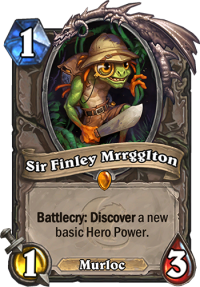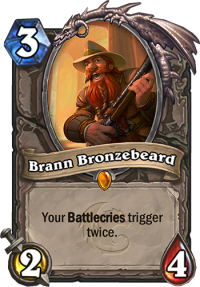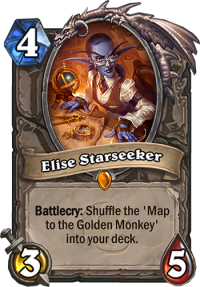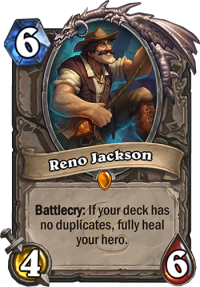The upcoming Core Set rotation will bring back the original League of Explorers cards into the Standard rotation, over 6 years after their original release. With all the changes in card design and power levels since then, how will they hold up in this new environment?
A Return From the Museum
The League of Explorers characters are some of the absolute fan favorites in the Hearthstone community, and it’s little wonder they’ve returned in a wide variety of different forms over the years. These new takes on the characters were made with a deeper understanding of Hearthstone’s underlying mechanics and a few extra years’ worth of design philosophy changes. We went from Elise Starseeker to Elise the Trailblazer to Elise the Enlightened, revisiting and readjusting the same principles: it will be really interesting to see just how well the originals will hold up and how they compare to their modern counterparts.
Though the four Explorers are members of the same league, they’re cut from a very different cloth in terms of their utility in a 30-card deck: this means they have very different chances of seeing play in the Year of the Hydra. For veteran players, the mere opportunity to play with them again outside of the confines of Wild is to be celebrated – but let’s discuss what they bring for the tryhards out there.
Sir Finley Mrrgglton: The Tiny Aggro Enabler

Who’s up for an aggro deck? That’s the question you had to answer before deciding whether to include Sir Finley Mrrgglton in your deck. His role was simple and straightforward: the chance for a significant upgrade for classes who could very much use a more aggressive Hero Power to make their deck work. Couple this with a perfectly viable early-game minion, and you had a winner.
This power level designation seems like what we’ve got going with future iterations of Sir Finley as well. The Paladin class restriction on Sir Finley of the Sands meant that it lived and died based on the class’ overall set of options without being powerful enough to enable a highlander deck by himself. Meanwhile, the viability of Sir Finley, Sea Guide will have much more to do with Dredge options (or the strength of combo strategies) than anything else. Just like the original, it is looking like a very good utility minion.
Fast-forward to today, and even in an era where Team 5 felt it was appropriate to print a neutral tribeless 1-mana 2/2 minion, 1/3 remains a desirable statline for aggressive decks. The effect is also still very much worthwhile for the classes whose Hero Powers don’t mesh well with these strategies: Warriors, Shamans, and even Druids will very much enjoy trying to roll into Life Tap and Steady Shot as the premium options. The addition of Demon Hunter and their unique 1-mana Hero Power also improves the odds of finding an impactful replacement. If the classes in question will have enough juice to build a competitive aggro deck, Sir Finley Mrrgglton will be at their service – but the little explorer won’t be able to push an archetype into existence by himself.
Brann Bronzebeard: The Swiss Army Knife

There has never been a more obvious combo card in the history of the game than Brann Bronzebeard, and I wonder if there are any recorded instances of it being played as a 3-mana 2/4 on curve. Perhaps against the most aggressive of opponents, sometimes?
By the same token, Brann can be useful in all but the most aggressive of decks, even without any specific setup. Though he can also play a part in combo finishers (more on that later), there were powerful enough Battlecry effects in the game even back in 2015 that made his inclusion worthwhile in a wide variety of midrange-to-control decks. With the Battlecry effects increasing in power level since (much like everything else), the nature of Brann’s effect means he’s able to keep up with the times.
Of all the Explorers, Brann’s reimagining in the form of Dinotamer Brann was the oddest of the bunch. The thematic link is tenuous at best and the statline is clearly an afterthought: the 7-mana King Krush was the point all along. It was a good card, just not a very interesting one – unlike the original.
The fact that the developers already had to nerf Pandaren Importer to preemptively counter an OTK setup including Brann Bronzebeard should tell you everything you need to know about his future viability. It is an incredibly strong effect that will remain a Constructed staple for years to come.
Elise Starseeker: The One Who Failed to Keep Up With the Times

Oh Elise. Of all the Explorers, she’s the one who’s aged the worst. Back in November 2015, a 4 mana 3/5 was reasonable to play on the board, which is no longer the case. Having to waste a draw and two mana to shuffle the Map to the Golden Monkey into your deck is also a pain in the ass. Even the ultimate payoff’s value is questionable at best: Arch-Thief Rafaam showed that the effect itself isn’t all that powerful, and even back in those days, Elise was specifically in Control Warrior and Control Warrior only to replace worthless removal tools in the mirror. In many cases, those games came down to who found the Golden Monkey first. The card is extremely flavorful but will most likely lack any competitive viability in the Year of the Hydra.
Elise the Trailblazer improved on the stats and the payoffs as well, but even that card might not be relevant these days in Constructed. As for Elise the Enlightened, Druids rarely managed to achieve the consistency needed for a Highlander deck, and the card was mostly used as a vanilla 5/5 with incredible late-game highroll potential for regular decks. It is nevertheless clearly much stronger than the original Elise Starseeker. It’s interesting to see how the devs kept increasing the power level of the “add valuable cards to your hand” minion over the year, but it only goes to show how underpowered the original is now.
Reno Jackson: The Rich Bastard

To call Reno Jackson archetype-defining would be an understatement. A single payoff card was enough to single-handedly (or -hattedly?) enable Highlander decks in Hearthstone. In those days, healing upwards to 30 on a card that only lost 2/1 worth of stats from the vanilla test for the effect was nothing short of incredible. It could win aggro matchups by itself and allow you to take greedier lines in slower matchups, or maybe even distort the fatigue math in ultra-control decks.
The real question is whether the game’s become too fast (and the burn effects too numerous) to make a mere 30 health enough to make you want to give up on the consistency of duplicates in your deck. It’d be tough to imagine Reno making any difference against the strongest of Questline decks in their original form, for instance.
However, even if the highlander decks only hit the heady heights of tier 2, the fact that you can finally play them again with a strong neutral payoff is a great gameplay experience. (Unlike Reno the Relicologist and The Amazing Reno, which could only be used in the same solitary railroaded archetype.)
These decks allow for the most tinkering even when the lists are established, and perhaps it’s not unreasonable to expect some support cards over the next Hearthstone year. Surely the golden dragon in human form was brought back for a purpose?

Brann actually got better over the years lol, he is still one of the best cards in the game due to how much stuff he just enables by existing
Expecting to see some new highlander cards in the next expansion. Seems like that’s the general MO.
Oh men, i love Brann. Just for memes, the best tool. <3 And maybe be good. ????
Old explorers feel outdated in today’s standards but new players have a chance to play them in a different context oc, but all the 4 are good un their role.